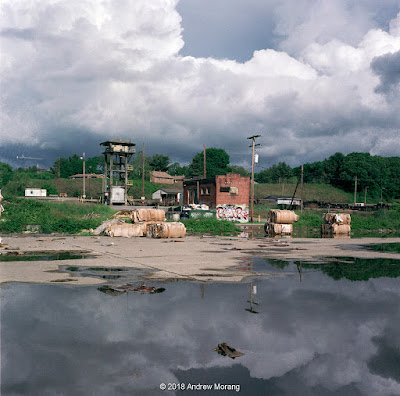 |
| Map from ESRI ArcGIS online. Red dashed line shows the route from Asheville to Hot Springs, North Carolina. |
Every year,
The Vintage rally for older BMW automobiles is held in Hot Springs, North Carolina. Most participants stay in the Asheville area, so the day of the show sees hundreds of classic BMWs streaming north on I-26 and US25/US70 towards the small hamlet of Hot Springs. Once the group leaves the interstate at Weaverville, US25/US70 winds in and out of the hills, past small towns and farms, and past some occasional bits of rural decay.
 |
| This is a streamlined/moderne-style filling station, possibly once a Mobil station, but a gas station archaeologist needs to weigh in and provide an identification. |
Marshall has a number of old garages and filling stations. The main town is out of sight west of US25 and 70.
I also saw old barns or sheds in the Marshall area, slowly being engulfed by trees and vines. I usually think of Mississippi being the place where the jungle takes over, but here in wet western North Carolina, the same happens.
Further north, somewhere in Madison County, I saw a similar vine-engulfed barn during my 2017 trip.
 |
| Barn, US25, Madison County, NC. |
The second photograph is a former gas station built into a house, or a house built on top of a gas station. You can see the island where the pumps were once located.
 |
| Rick's Gro, 10994 US25 (digital photograph from Fujifilm X-E1 camera). |
USA Raft at 13490 US70 occupies an unusual stone-clad filling station. You can see where one of the service bays on the left was filled in. Again, I cannot identify the original fuel brand.
The Laurel River Store is a friendly place to stop for an espresso. The lady who runs it is very nice. A number of the BMW drivers stopped to tank up (with coffee, that is, but the coffee might have had enough octane for the carbureted engines).
The remains of a log trailer court cabin were to the right of the Laurel River Store. Some units beyond this building were in better shape. The vines are taking over.
Just before you reach Hot Springs, US70 crosses the French Broad River. There had been almost monsoonal rain in May of 2018, and the river was in flood, with brown water roiling angrily downstream.
Finally, Hot Springs, and the grounds of the Hot Springs Spa. The 2017 show was sunny and warm; 2018 started out dry, but by 2:30, the rain came thundering down. Regardless, a good time was had by all, and it was a good chance to check if your car leaked (mine certainly does).
The 2017 black and white photographs are from Tri-X film and a Hasselblad 501CM camera. The 2018 square frames are from long-expired Fuji NPH400 film, exposed in a Rolleiflex 3.5E camera with 75mm f/3.5 Xenotar lens.





























































